paithani textile
Paithani is a varient of Traditional Sari, named after the Paithan village in Aurangabad, Maharashtra state of India where these sari's where hand woven. The art of weaving Paithani goes the way till 7th century B.C. during the Yadav period (Sri Krishna's period), however flourished in 200B.C., during Satvahana era. Since then Paithani is coveted in India as a precious heirloom passing on from generation to generation. Exquisite silk from Paithani was exported to many countries and was traded in return for gold and precious stones. Sheer dedication and the faith of the weavers have kept alive Paithani silk work for more than 2000 years. Intricate designs on pallu and border is a specialty of Paithani Sarees. Motifs on pallu are generally peacock, lotus, mango and other designs inspired from the world famous Ajanta Caves, which are in the same district. Paithani saris were produced only for sophisticated buyers. It evolved from a cotton base to a silk base. Silk was used in weft designs and in the borders, whereas cotton was used in the body of the fabric. Present day Paithani has no trace of cotton. Paithani Sarees can take between 2 months to 1 year to manufacture, depending on border, pallu design and the material used.
Motifs
The motifs are traditional vines and flowers, shapes of fruit and stylized forms of birds and the saree is often known by the motif that dominates its border or pallav. There are various types of exquisite motifs.
- The Kamal or lotus flower on which Buddha sits or stands
- The Hans motif
- The Ashraffi motif
- The Asawalli (flowering vines), became very popular during the Peshwa's period
- The Bangadi Mor, peacock in bangle
- The Tota-Maina
- The Humarparinda, peasant bird
- The Amar Vell
- The Narali motif, very commo
Small motifs like circles, stars, kuyri, rui phool, kalas pakhhli, chandrakor, clusters of 3 leaves, were very common for the body of the sari.
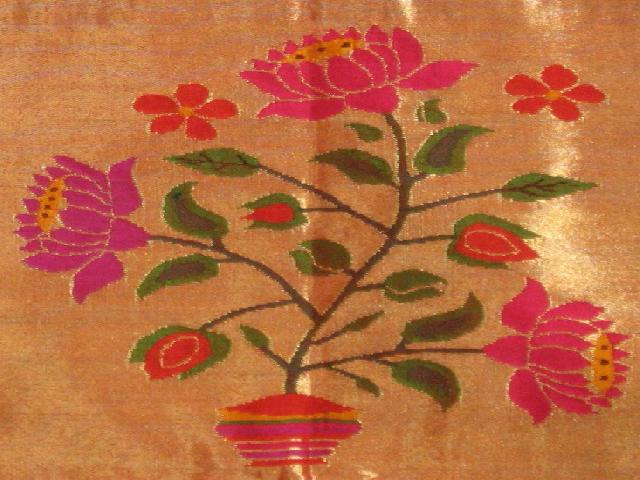
Paithani Colors
The modern technology has brought in a lot of progress in dyeing technology and variations in colors, however the Traditional Paithani colors were produced from vegetable dyes.
- Pophali - yellow
- Red
- Lavender
- Purple
- Neeligunji - sky blue
- Magenta
- Motiya - peach pink
- Brinjal - purple
- Pearl pink
- Peacock - blue/green
- Yellowish green
- Kusumbi - violet red
- Pasila - red and green
- Gujri - black and white
- Mirani - black and red
Loom
It took approximately 1 day to set the silk threads on the loom. "Tansal" is used to put the "wagi". The "pavda" works like the paddle to speed up the weaving. The "jhatka" is used to push the "kandi" from one side to the other. "Pushthe" is used in designing the border of Paithani in which it is punched according to design application. "Pagey" are tied to the loom. The threads are then passed through "fani". There are two types of motion:
-
Primary motions:
- Shedding - dividing the warp sheet or shed into two layers, one above the other for the passage of shuttle with the weft threads.
- Picking - passing a pick of weft from one selvedge of a cloth through the warp threads.
- Beating - dividing the last pick through the fell of cloth with the help of slay fixed on the reel.
-
Secondary motions:
- Take up motion - taking up the cloth when being woven and winding it on the roller.
- Let off motion - letting the warp wound on a warp beam, when the cloth is taken up on the cloth roller beam. Taking up and letting off the warp are done simultaneously.
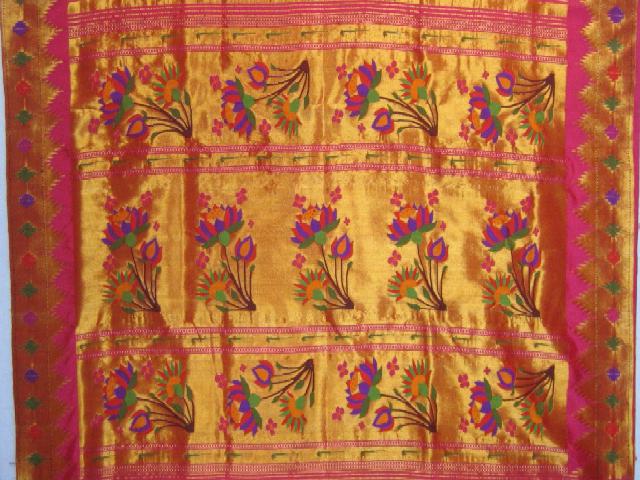
Weaving
Paithani saris are silks in which there is no extra weft forming figures. The figuring weave was obtained by a plain tapestry technique. There are three techniques of weaving:
- Split tapestry weave - the simplest weave where two weft threads are woven up to adjacent warp threads and then reversed. The warp threads are then cut and retied to a different colour.
- Interlocking method - two wefts are interlocked with each other where the colour change is required. The figuring weft is made of a number of coloured threads, weaving plain with warp threads and interlocked on either side with the grounds weft threads are invariably gold threads which interlock with the figure weft threads, thus forming the figure. This system of interlocking weaves, known as kadiyal, is done so that there are no extra floats on the back of the motif thus making the design nearly reversible.
- Dobe-tailing method - two threads go around the same warp, one above the other, creating a dobe-tailing or tooth-comb effect.
Weaving could take between 18 to 24 months, depending upon the complexity of the design. Today there are many weavers who are working for the revival of this treasured weave.
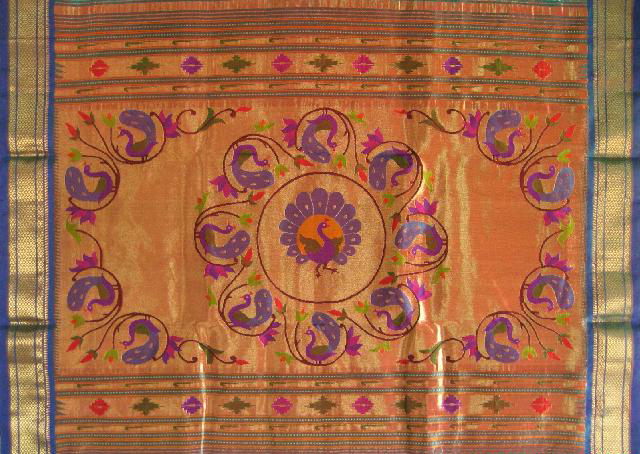
-
Types of Paithani
Paithani can be classified by three criteria: motifs, weaving, and colours.
-
Classification by motif:
- Bangadi Mor - the word bangadi means bangle and mor means peacock. So bangadi mor means a peacock in a bangle or in a bangle shape. The motif is woven onto the pallu, the design sometimes having a single dancing peacock. The saris using this motif are very expensive because of the design.
- Munia brocade - The word munia means parrot. Parrots are woven on the pallu as well as in border. Parrots are always in leaf green colour. The parrots in silk are also called tota-maina.
- Lotus brocade - lotus motifs are used in pallu and sometimes on the border. The lotus motif consists of 7-8 colours.
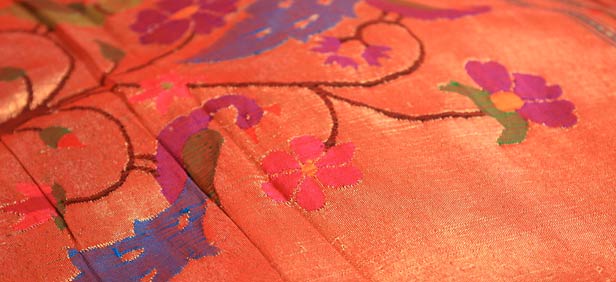
-
Classification by weaving:
- Kadiyal border sari - the word kadiyal means interlocking. The warp and the weft of the border are of the same colour while the body has different colours for warp and weft.
- Kad/Ekdhoti - a single shuttle is used for weaving of weft. The colours of the warp yarn is different from that of the weft yarn. It has a narali border and simple buttis like paisa, watana, etc. Kad is also a form of lungi and is used by male Maharashtrians.
-
Classification by colour:
- Kalichandrakala - pure black sari with red border.
- Raghu - parrot green coloured sari.
- Shirodak - pure white sari.
Select Your Next Chapter

Paithani
Paithani is a varient of Traditional Sari, named after the Paithan village in Aurangabad, Maharashtra state of India where these sari's where hand woven.

Kashmiri Shawls
Learn about how research has been reinvented at Discovery Park, how collaborations among scientists and stakeholders are seeking solutions to grand challenges, and the impacts of discovery.

Block Printing
Discovery Park is delivering on Purdue's land-grant mission to serve the people of Indiana and the nation. Large-scale research drives economic development in a knowledge economy and Discovery Park is the engine.
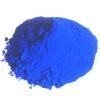
Natural Vedetable Dyes
The art of making natural dyes is one of the oldest known to human. In India, it was used for colouring fabric and other materials.

Durries
>The weavers of the village of Salawas belong to the Prajapati caste. Although their main source of income was agriculture, they also practiced pottery and the weaving of jatpatti rugs.
Select Your Next Chapter

Sarees
'Jamdani' is a heritage handloom products of Bengal handloom. Word 'Jamdani' - derived from a "PERSION" word 'JAM' meaning a 'cup' and 'DANI' denotes the 'container'.

Pichwai
India, wrapped in mystique, enhanced with the romance of fabled crafts, has one of the finest textile traditions in the world. Rajasthan is the home rather museum of paintings.